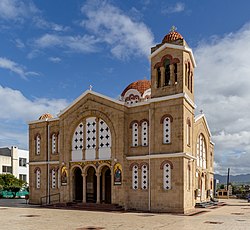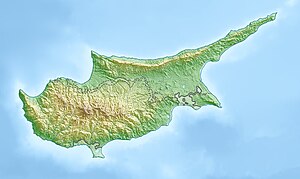Polis, Cyprus
This article contains content that is written like an advertisement. (July 2015) |
Polis Chrysochous | |
|---|---|
 | |
 Seal | |
 Polis Chrysochous Location in Cyprus | |
| Coordinates: 35°2′0″N 32°26′0″E / 35.03333°N 32.43333°ECoordinates: 35°2′0″N 32°26′0″E / 35.03333°N 32.43333°E | |
| Country | |
| District | Paphos District |
| Government | |
| • Mayor | Yiotis Papachristofi |
| Population (2011)[1] | |
| • Total | 3,690 |
| Time zone | UTC+2 (EET) |
| • Summer (DST) | UTC+3 (EEST) |


Polis (or Polis Chrysochous; Greek: Πόλη Χρυσοχούς or Πόλις Χρυσοχούς, Turkish: Poli) is a small town at the north-west end of the island of Cyprus, at the centre of Chrysochous Bay, and on the edge of the Akamas peninsula nature reserve. It is a quiet tourist resort, the inhabitants' income being supplemented by agriculture and fishing.
Polis is served by the fishing port of Latchi. Polis is close to the beautiful Akamas peninsula, a nature reserve.
History[]
Marion (the original name of Polis) was already inhabited at the end of the Neolithic and through the Chalcolithic period. It began to prosper from the period onwards and became one of the most important ancient Cypriot city—kingdoms in the period with important commercial relations with the East Aegean islands, Attica and Corinth. In 312 BC, it was conquered by Ptolemy I and the kingdom was abolished until its reconquest by Ptolemy II Philadelphus who renamed the city after his sister and wife. The new city was smaller than Marion but it also flourished due to its close proximity to the copper mines.
In Egypt at Medinet Habu in the temples of Ramesses III, there is a large 12th-century BC inscription which refers to Cyprus. The names of Cypriot towns mentioned include Marion. However, the first definite reference to Marion occurred in 449 BC, when the city, as indeed other city-kingdoms of Cyprus, was under Persian rule. During that year, Kimon, the great Athenian general, freed the city from the Persians. Later, the ancient geographers spoke of the town as "Marion Ellinikon"—The Hellenic Marion. The Kingdom was rich in gold and copper ore, mined chiefly in the nearby . It was the natural wealth which led the city to a period of flourishing trade, especially with Athens, which in its turn, exported many Attic pots to Marion. Samples of this pottery can be viewed at the Polis Archaeological Museum.
According to tradition, Athenian Akamas, son of Theseus, disembarked near Polis after the Trojan war and gave his name to the and the city of Akamantis, a legendary city which has never been found. In ancient times, Polis was known as Marion, and was probably founded by Akamas or a certain Marieus. Marion was one of the city-kingdoms founded by the Mycenaeans when they came to Cyprus. The Mycenaeans, or Achaeans, were the creators of the Mycenaean civilization in Greece, and they settled in Cyprus between 1400 and 1100 BC. The Greek presence and the cities linked to the settlement of the Mycenaeans in Cyprus can be verified by inscriptions found in neighboring countries.
The harsh battle for Cyprus between the successors of Alexander the Great, Antigonus, and Ptolemy led Marion to destruction. Ptolemy, who finally prevailed, laid waste the city whose king had taken the side of Antigonus, and transferred its inhabitants to Paphos. Later, another member of the Ptolemy dynasty, Philadelphus, founded a new city on the ruins of Marion, and gave it the name of his wife, Arsinoe. The city, under its new name, prospered during the Hellenistic and Roman Ages.
In early Christian times it was the seat of a bishop.
In early Byzantine times it seems to have suffered extensive destruction during the period of the Muslim conquests of the 7th century.[citation needed] Archaeological evidence indicates that the city was also inhabited during the late Medieval period between the 12th and 14th centuries when reference was made to Chrysochou and later, Polis Chrysochou.
Facilities[]
The local Museum of Marion - Arsinoe at Polis was founded in 1998 by the Government of Cyprus and Nicos Shacolas. The museum consists of three exhibition spaces—Rooms I and II and the Atrium. Objects in Room I derive from an extensive area around Polis and are chronologically arranged, so as to portray its historical development from the Neolithic and Chalcolithic to the Medieval periods. Another museum, the Polis Culture Centre contains theatre stage and a 400-person capacity seating area.
The Baths of Aphrodite and the recently discovered ruins of the medieval Georgian Orthodox monastery of Gialia are located near the town.
Nowadays, Polis is the administrative centre of the area which includes 23 communities. The larger communities include the villages of Prodromi, Latchi, and Neo Chorio to the West, and Argaka and Gialia to the East.
Facilities include a campsite on the beach, several small hotels, at least one of each type of shop, one branch of each major Cypriot bank, and many bars and restaurants mainly clustered around the town square and the pedestrianised streets to the south. A small bus station acts as the hub of a network of infrequent bus routes connecting the outer villages as well as the near hourly 645 route to Paphos[2]
Facilities further afield include boat hire and boat trips from Latchi harbour, nature trails and walks from Baths of Aphrodite, and surfing and windboarding at Argaka. An almost unbroken chain of beaches runs from Aphrodite in the west to Gialia in the east and range from busy tourist ones equipped with sunbeds and cafes to more remotes ones only accessible by boat or 4WD vehicle.[3] The towns small bowling alley and pool hall closed during 2020
The Municipality puts on cultural events including traditional dances and music outside the town hall during the summer months and arranges other fetes and festivals throughout the year.[4]
Name[]
The village where the town gets its full name from, Chrysochou, is located about 2km inland to the south and the bay the whole region is located on is called Chrysochou bay. The greek word "Polis" simply means city or city-state, so the towns full name, Polis Chrysochou, is derived from it being the administrative centre for the region. Chrysochou in turn derives its name from the greek word "Chryso" meaning gold, after its first settler, a goldsmith.[5]
Climate[]
| hideClimate data for Polis | |||||||||||||
|---|---|---|---|---|---|---|---|---|---|---|---|---|---|
| Month | Jan | Feb | Mar | Apr | May | Jun | Jul | Aug | Sep | Oct | Nov | Dec | Year |
| Average high °C (°F) | 16.4 (61.5) |
16.3 (61.3) |
18.5 (65.3) |
21.5 (70.7) |
26.1 (79.0) |
30.5 (86.9) |
33.5 (92.3) |
33.3 (91.9) |
29.9 (85.8) |
26.5 (79.7) |
21.9 (71.4) |
17.8 (64.0) |
24.3 (75.7) |
| Daily mean °C (°F) | 12.1 (53.8) |
11.8 (53.2) |
13.5 (56.3) |
16.3 (61.3) |
20.4 (68.7) |
24.7 (76.5) |
27.6 (81.7) |
27.6 (81.7) |
24.6 (76.3) |
21.4 (70.5) |
17.2 (63.0) |
13.6 (56.5) |
19.2 (66.6) |
| Average low °C (°F) | 7.9 (46.2) |
7.3 (45.1) |
8.6 (47.5) |
11.1 (52.0) |
14.7 (58.5) |
18.8 (65.8) |
21.6 (70.9) |
21.8 (71.2) |
19.3 (66.7) |
16.3 (61.3) |
12.4 (54.3) |
9.4 (48.9) |
14.1 (57.4) |
| Average precipitation mm (inches) | 79.9 (3.15) |
67.1 (2.64) |
37.6 (1.48) |
24.7 (0.97) |
7.20 (0.28) |
1.50 (0.06) |
0.20 (0.01) |
0.00 (0.00) |
4.40 (0.17) |
21.8 (0.86) |
55.3 (2.18) |
94.4 (3.72) |
394.2 (15.52) |
| Average precipitation days (≥ 1 mm) | 10.1 | 8.3 | 6.5 | 4.2 | 1.8 | 0.2 | 0.1 | 0.0 | 0.6 | 2.9 | 5.7 | 9.1 | 49.4 |
| Mean monthly sunshine hours | 192.2 | 211.7 | 254.2 | 291.0 | 359.6 | 387.0 | 399.9 | 378.2 | 318.0 | 279.0 | 219.0 | 182.9 | 3,472.7 |
| Source: Meteorological Service (Cyprus)[6] | |||||||||||||

Popular culture references[]
Ruth Evershed a fictional MI5 analyst and spy at the Spooks series, lived in Polis for some time.
See also[]
References[]
- ^ "C1. POPULATION ENUMERATED BY SEX, AGE, DISTRICT, MUNICIPALITY/COMMUNITY AND QUARTER (1.10.2011)", Population - Place of Residence, 2011, Statistical Service of the Republic of Cyprus, 2014-04-17, archived from the original on 2014-04-20, retrieved 2014-04-20
- ^ "Polis Main Bus Station - Pafos Transport Organization - Buses in Paph". www.pafosbuses.com. Retrieved May 30, 2021.
- ^ https://www.polistourism.com/
- ^ "Events in Polis Region Pafos area Cyprus". May 11, 2015. Retrieved May 30, 2021.
- ^ Lloyd, Dominic. "Chrysochou". Paphos Life. Retrieved May 30, 2021.
- ^ "Meteorological Service - Climatological and Meteorological Reports". Retrieved May 30, 2021.
External links[]
- Polis, Cyprus
- Cities in ancient Cyprus
- Municipalities in Paphos District
- Populated coastal places in Cyprus
- Mycenaean Greece


